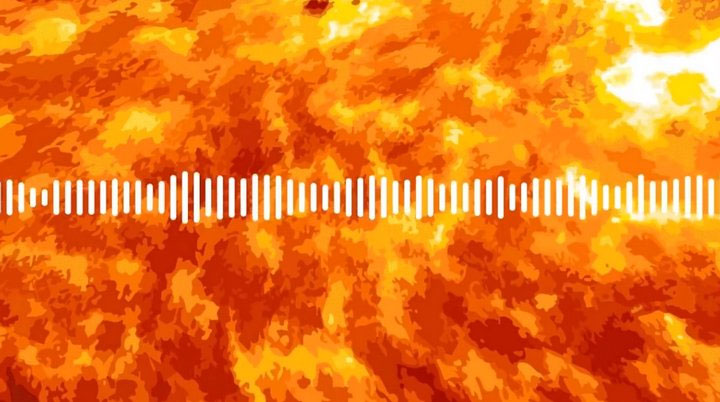Come on, listen to the sound from the Sun!
It turned out that the sound emanating from the Sun had the same tone as a human song.
ESA and NASA recently announced that the tape is said to be sound emitted from the surface of the Sun. This audio track is recorded in NASA's ESA (European Space Agency) dataset and NASA's Solar and Heliospheric Observatory (SOHO) Spacecraft .
The data set over the age of 20 years records the movements of the atmosphere outside the Sun. Since then, how scientists can listen to eruptions, physical waves, the Sun's rotation. Especially this sound helps people study many things that are difficult to observe with the naked eye if there is not enough sensitivity.

NASA's space probe has measured the vibration of the Sun, then converted them into sound.
Alex Young, deputy director of science at NASA Aviation Center in Greenbelt, Maryland, said: "There are waves moving and spreading around the Sun. If your eyes are sensitive enough, you can see this. ".
After recording raw data, Stanford Experimental Physics Lab processed audio and produced the final audio file for everyone to hear and feel. To be able to map data into audio, we need to set a general rule for a data set. This is the main method used to decode unreadable or accessible data.
Also according to NASA, NASA's space probe has measured the vibration of the Sun , then converted them into sound, serving to study the movements of the Sun, such as flare to physical eruption. on the surface.
Young said: "We have no way to look directly into the Sun. We don't even have a microscope to zoom inside the Sun. So we have to use the star or the vibration. of the Sun to observe inside it ".
In order to produce the above soundtrack, researcher Alexander Kosovichev of Stanford University took up to 40 days to process data from the SOHO's Michelson Doppler Imager camera. During this process, Kosovichev had to eliminate the effects of the ship's motion, select the clearest sound waves and minimize them to match the sound range of the human ear.
- Listen to 'the sound of ... the Lord'
- Listen to the mysterious sound obtained from the deepest
- The scaryness of sound: saving people and destroying each other in a narrow way!
- This is why the right ear hears better than the left ear
- New devices help listen to the sound of each cell
- Listen to the exciting ASMR sounds of experiments and chemical reactions
- Listen to livestream sound from the sea floor, will you be lucky to hear the dolphin?
- Video: The journey to listen to the heart of the Earth mother
- Avoid annoying noise with sound insulation
- Listen to every rhythm from the universe with supercomputers
- Recreate the world's first recording hidden in Thomas Edison doll
- Listen to the sound of the ocean
 Van Allen's belt and evidence that the Apollo 11 mission to the Moon was myth
Van Allen's belt and evidence that the Apollo 11 mission to the Moon was myth The levels of civilization in the universe (Kardashev scale)
The levels of civilization in the universe (Kardashev scale) Today Mars, the sun and the Earth are aligned
Today Mars, the sun and the Earth are aligned The Amazon owner announced a secret plan to build a space base for thousands of people
The Amazon owner announced a secret plan to build a space base for thousands of people Rare moment Mercury passes the Sun captured by spacecraft
Rare moment Mercury passes the Sun captured by spacecraft  Top 5 lands where the sun never sets, where 'sunset never reaches'
Top 5 lands where the sun never sets, where 'sunset never reaches'  Rare detailed image of sunspot
Rare detailed image of sunspot  Why are the sun's outer rings so much hotter than the inner core?
Why are the sun's outer rings so much hotter than the inner core?  'Planet 9' left its mark on Earth before disappearing?
'Planet 9' left its mark on Earth before disappearing?  Could the Sun Capture a New Planet, Changing Life on Earth?
Could the Sun Capture a New Planet, Changing Life on Earth? 